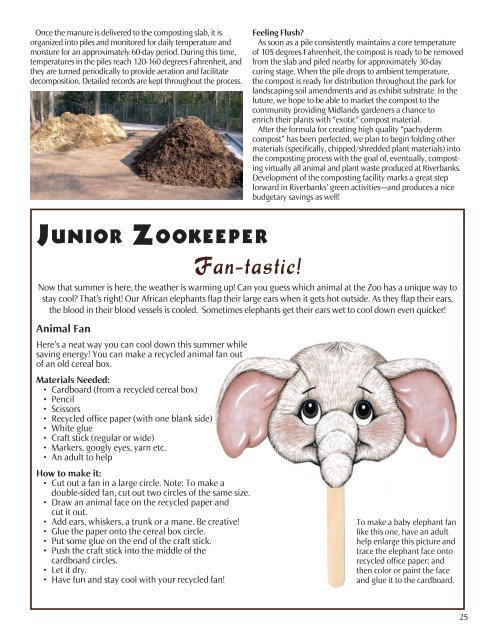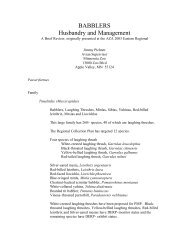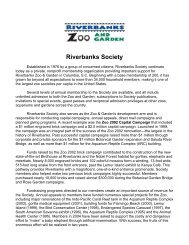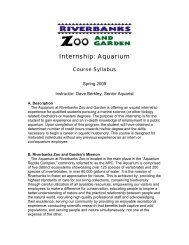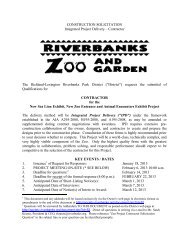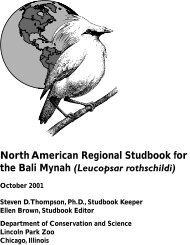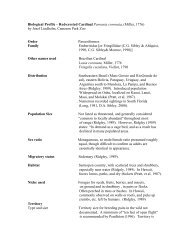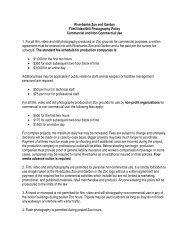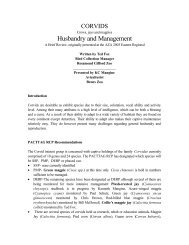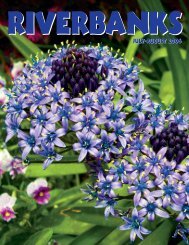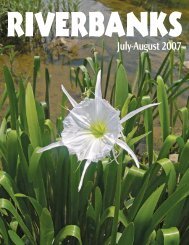Riverbanks Volume XXVIII, Number 3 - Riverbanks Zoo and Garden
Riverbanks Volume XXVIII, Number 3 - Riverbanks Zoo and Garden
Riverbanks Volume XXVIII, Number 3 - Riverbanks Zoo and Garden
Create successful ePaper yourself
Turn your PDF publications into a flip-book with our unique Google optimized e-Paper software.
Once the manure is delivered to the composting slab, it is<br />
organized into piles <strong>and</strong> monitored for daily temperature <strong>and</strong><br />
moisture for an approximately 60-day period. During this time,<br />
temperatures in the piles reach 120-160 degrees Fahrenheit, <strong>and</strong><br />
they are turned periodically to provide aeration <strong>and</strong> facilitate<br />
decomposition. Detailed records are kept throughout the process.<br />
<br />
Fan-tastic!<br />
Feeling Flush?<br />
As soon as a pile consistently maintains a core temperature<br />
of 105 degrees Fahrenheit, the compost is ready to be removed<br />
from the slab <strong>and</strong> piled nearby for approximately 30-day<br />
curing stage. When the pile drops to ambient temperature,<br />
the compost is ready for distribution throughout the park for<br />
l<strong>and</strong>scaping soil amendments <strong>and</strong> as exhibit substrate. In the<br />
future, we hope to be able to market the compost to the<br />
community providing Midl<strong>and</strong>s gardeners a chance to<br />
enrich their plants with “exotic” compost material.<br />
After the formula for creating high quality “pachyderm<br />
compost” has been perfected, we plan to begin folding other<br />
materials (specifically, chipped/shredded plant materials) into<br />
the composting process with the goal of, eventually, composting<br />
virtually all animal <strong>and</strong> plant waste produced at <strong>Riverbanks</strong>.<br />
Development of the composting facility marks a great step<br />
forward in <strong>Riverbanks</strong>’ green activities—<strong>and</strong> produces a nice<br />
budgetary savings as well!<br />
Now that summer is here, the weather is warming up! Can you guess which animal at the <strong>Zoo</strong> has a unique way to<br />
stay cool? That’s right! Our African elephants flap their large ears when it gets hot outside. As they flap their ears,<br />
the blood in their blood vessels is cooled. Sometimes elephants get their ears wet to cool down even quicker!<br />
Animal Fan<br />
Here’s a neat way you can cool down this summer while<br />
saving energy! You can make a recycled animal fan out<br />
of an old cereal box.<br />
Materials Needed:<br />
<br />
<br />
<br />
<br />
<br />
<br />
<br />
<br />
How to make it:<br />
<br />
double-sided fan, cut out two circles of the same size.<br />
<br />
cut it out.<br />
<br />
<br />
<br />
<br />
cardboard circles.<br />
<br />
<br />
To make a baby elephant fan<br />
like this one, have an adult<br />
help enlarge this picture <strong>and</strong><br />
trace the elephant face onto<br />
recycled office paper; <strong>and</strong><br />
then color or paint the face<br />
<strong>and</strong> glue it to the cardboard.<br />
25


